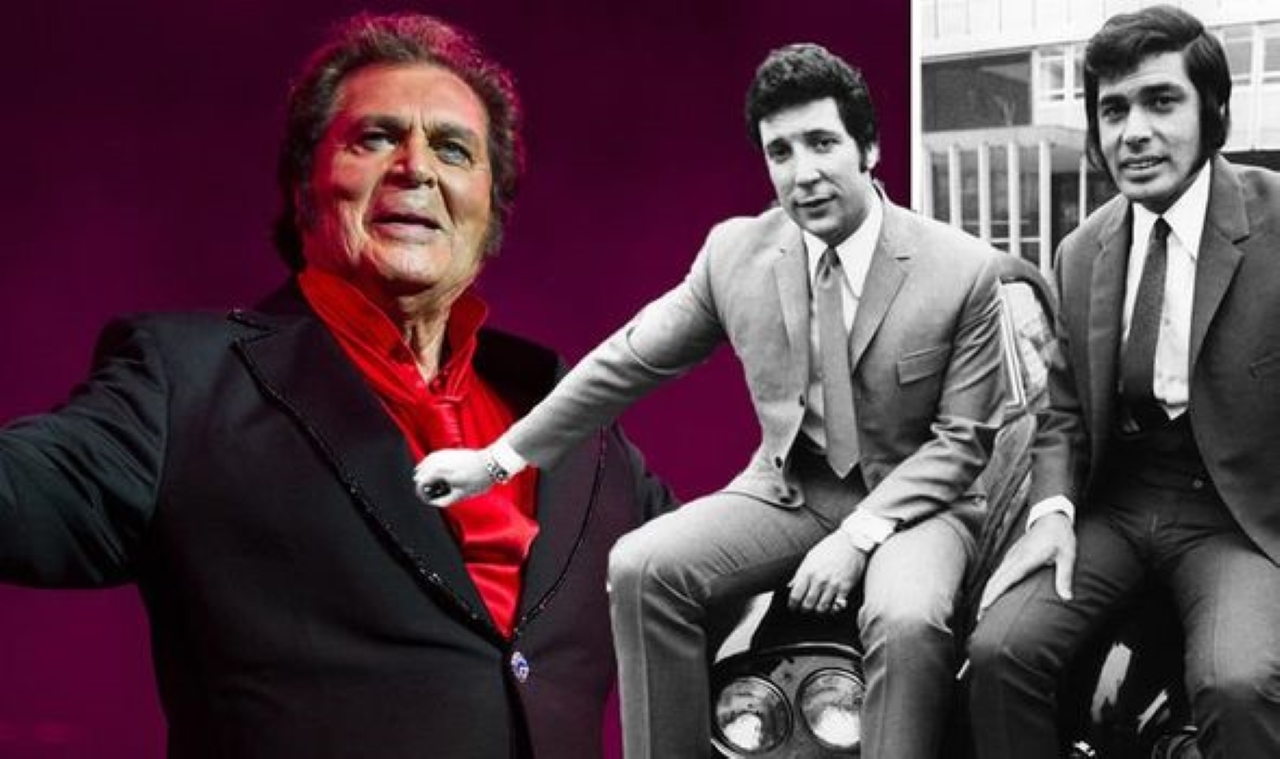🎧 Two Voices, One Era
By 1967, British music wasn’t just about The Beatles and The Rolling Stones. In the space between pop’s frenzy and rock’s swagger, two male vocalists emerged who could stop time with a single note.
Tom Jones, the son of a Welsh coal miner, broke through with “It’s Not Unusual”—a blast of raw energy, charisma, and a voice that could shake walls. He moved like Elvis, dressed like a peacock, and sang like every song was a seduction.
Engelbert Humperdinck, born Arnold Dorsey, was the opposite kind of force. Dressed in velvet suits, he stood still, smiled softly, and let his deep, honeyed baritone do the work. With “Release Me,” he wasn’t shaking hips—he was breaking hearts.
Different styles. Same goal: to own the romantic stage.
💎 The Gentleman vs. The Tiger
If Tom Jones was the wild, untamed flame, Engelbert was the steady candlelight.
Tom’s performances were electric storms. He prowled the stage, sweat dripping, shirts open wide, grabbing the mic like it might run away. Women screamed, threw undergarments, and fainted in the aisles.
Engelbert’s shows were slow dances in sound. He didn’t need to move much—just a glance, a slight lift of his hand, a subtle turn of his head. His allure wasn’t in movement, but in presence. If Tom made you feel like the only woman in the room, Engelbert made you feel like the only woman in the world.
The contrast was part of the magic. They weren’t competing to be each other—they were competing to be the one you remembered more.
📈 Chart Battles and Silent Tensions
Their rivalry became most visible on the UK charts.
When “Release Me” kept The Beatles from reaching No. 1 in 1967, Engelbert instantly became Tom’s equal in fame. The same year, Tom scored with “I’ll Never Fall in Love Again” and continued to dominate internationally, especially in the US.
They often released singles close to each other’s dates. Radio DJs inevitably compared them. Fans debated in living rooms. Was Tom’s fire more thrilling than Engelbert’s velvet? Or did Engelbert’s sincerity cut deeper than Tom’s swagger?
The two men kept their words polite, but there was no doubt: each wanted the bigger stage, the better slot, the louder applause.
🌍 America: The Real Battleground
While both men were adored in the UK, it was the United States that truly became the arena for their competition.
Tom had This Is Tom Jones, a US television variety show that ran from 1969 to 1971, bringing his magnetic personality into millions of American homes.
Engelbert responded with The Engelbert Humperdinck Show in 1972, offering a more refined, classic showcase of music and conversation.
In Las Vegas, they became headlining staples—often performing in different casinos at the same time. It was as if the Strip itself had split into two romantic kingdoms: one ruled by a Welsh lion, the other by an English gentleman.
💔 Different Weapons, Same Target
Tom Jones sang “She’s a Lady” with swagger and a wink. Engelbert sang “The Last Waltz” with longing and finality. Tom’s ballads felt like promises. Engelbert’s felt like farewells.
Yet both men shared the same mastery of connection. Neither hid behind the band. Neither overcomplicated the performance. They faced the audience head-on, eye to eye, note to note.
And they both understood one truth: the real romance was in making every person in the room believe the song was for them alone.
🕯️ Friendship in the Shadows
Despite the competitive undertones, Tom and Engelbert maintained a friendship over the decades. They were never seen trading insults in the press. In fact, both publicly praised each other’s talents.
In interviews, Engelbert called Tom “a powerhouse performer,” while Tom admitted he respected Engelbert’s control and vocal warmth.
Still, they couldn’t ignore the comparisons. The press loved the “two kings” narrative, and audiences fueled it by picking sides—Team Tom or Team Engelbert.
Behind the scenes, they were two men in the same rare position: navigating fame, fan obsession, and the pressure to constantly outdo themselves.
🎼 Legacy: Two Crowns, One Throne
By the 1980s, musical tastes shifted. Disco, punk, and new wave took the spotlight. Yet, both Tom and Engelbert adapted. Tom leaned into soul and pop crossovers. Engelbert embraced country influences and global touring.
Today, their rivalry feels less like a fight and more like a shared legacy. They proved that romance could sell millions, fill stadiums, and define an era. They also showed that there was more than one way to be a romantic hero.
For Tom, it was through fire. For Engelbert, it was through velvet.
🎙️ Conclusion: The King Is… Both
So, who was Britain’s true King of Romance? The truth is, the crown was big enough for two.
Tom Jones gave romance its swagger. Engelbert Humperdinck gave it its grace. Together, they defined what it meant to be a male balladeer in the late 20th century.
And if you ask their fans, the answer is simple: you didn’t have to choose. You could dance with Tom, then waltz with Engelbert.
Because sometimes, the best rivalries leave everyone richer—especially the audience.
